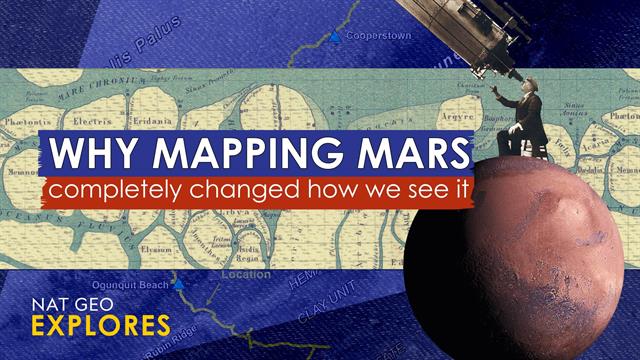The Contentious Cartography Of Mars: Shaping Public Perception

Welcome to your ultimate source for breaking news, trending updates, and in-depth stories from around the world. Whether it's politics, technology, entertainment, sports, or lifestyle, we bring you real-time updates that keep you informed and ahead of the curve.
Our team works tirelessly to ensure you never miss a moment. From the latest developments in global events to the most talked-about topics on social media, our news platform is designed to deliver accurate and timely information, all in one place.
Stay in the know and join thousands of readers who trust us for reliable, up-to-date content. Explore our expertly curated articles and dive deeper into the stories that matter to you. Visit NewsOneSMADCSTDO now and be part of the conversation. Don't miss out on the headlines that shape our world!
Table of Contents
The Contentious Cartography of Mars: Shaping Public Perception
The red planet has captivated humanity for centuries, fueling dreams of exploration and inspiring countless works of science fiction. But our understanding of Mars, and indeed, the very way we see it, is inextricably linked to the maps we create. The cartography of Mars, far from being a purely scientific endeavor, is a complex process laden with biases, interpretations, and ultimately, significant influence on public perception. This contentious process shapes not only our scientific understanding but also our cultural imagination of this enigmatic world.
From Early Observations to High-Resolution Imaging: A History of Martian Mapping
Early maps of Mars, drawn from telescopic observations, were necessarily rudimentary. They depicted broad features, often reflecting the biases and limitations of the technology of the time. These early representations, while inaccurate by today's standards, played a crucial role in igniting public fascination. The canals famously "observed" by Schiaparelli and Lowell, though later debunked, captured the public imagination and fueled speculation about Martian civilization. This highlights the power of cartography in shaping narratives, even when based on flawed data.
The Impact of NASA's Missions: High-Definition Reality vs. Public Imagination
The advent of space exploration, spearheaded by NASA's Mariner and Viking missions, revolutionized Martian cartography. High-resolution images transmitted back to Earth revealed a vastly different landscape than previously imagined – a desolate, cratered world, devoid of the canals that had so captivated the public. However, even with the advanced technology, the process of mapping Mars remains subject to interpretation. Scientists must select which data to prioritize, how to represent complex geological formations, and ultimately, how to present this information to the public.
The Role of Color and Perspective in Shaping Perception
The color palettes used in Martian maps are not neutral; they reflect choices made by cartographers and scientists. These choices can subtly influence the viewer's perception of the planet's terrain and features. For example, the use of enhanced color can highlight subtle geological variations, making them appear more dramatic and potentially fueling speculation about past water activity or potential habitability. Similarly, the perspective chosen – whether a global view or a close-up of a specific feature – significantly alters the public's understanding of scale and context.
Controversies and Debates: Interpreting the Martian Landscape
The interpretation of Martian features remains a source of ongoing debate. The presence of methane in the Martian atmosphere, for example, has sparked heated discussions about the possibility of microbial life. The mapping of these features and their subsequent representation in publicly accessible resources significantly affects how this scientific debate is perceived and understood by the wider public. The way data is visualized—from the selection of colors to the use of 3D models—influences how the public comprehends the scientific findings and their implications.
The Future of Martian Cartography and Public Engagement
As missions to Mars continue to advance, the accuracy and detail of Martian maps will inevitably improve. However, the role of cartography in shaping public perception will remain crucial. It’s imperative that scientists and institutions prioritize transparency and effective communication in presenting this data to the public. Interactive maps, virtual reality experiences, and citizen science initiatives can help foster a more informed and engaged public understanding of Mars and its place in our solar system. The contentious cartography of Mars reminds us that scientific understanding is not simply a matter of objective data, but also a complex process of interpretation, representation, and communication.

Thank you for visiting our website, your trusted source for the latest updates and in-depth coverage on The Contentious Cartography Of Mars: Shaping Public Perception. We're committed to keeping you informed with timely and accurate information to meet your curiosity and needs.
If you have any questions, suggestions, or feedback, we'd love to hear from you. Your insights are valuable to us and help us improve to serve you better. Feel free to reach out through our contact page.
Don't forget to bookmark our website and check back regularly for the latest headlines and trending topics. See you next time, and thank you for being part of our growing community!
Featured Posts
-
 How Seattle Celebrates Juneteenth A Community Perspective
Apr 28, 2025
How Seattle Celebrates Juneteenth A Community Perspective
Apr 28, 2025 -
 Impacto Economico Das Greves Bilionarios Prejuizos Para Empresas E Setores
Apr 28, 2025
Impacto Economico Das Greves Bilionarios Prejuizos Para Empresas E Setores
Apr 28, 2025 -
 Inter Milan Vs Roma Prediction Team News Starting Lineups And Betting Odds
Apr 28, 2025
Inter Milan Vs Roma Prediction Team News Starting Lineups And Betting Odds
Apr 28, 2025 -
 Nyt Strands Answers April 27th Spangram Clues And Solutions
Apr 28, 2025
Nyt Strands Answers April 27th Spangram Clues And Solutions
Apr 28, 2025 -
 Grand Slam Outlook Nadal And Becker On Alexander Zverevs Future
Apr 28, 2025
Grand Slam Outlook Nadal And Becker On Alexander Zverevs Future
Apr 28, 2025
Latest Posts
-
 Delhi Capitals Death Bowling Tactics Criticized By Former Cricketers Kumble And Bangar
Apr 30, 2025
Delhi Capitals Death Bowling Tactics Criticized By Former Cricketers Kumble And Bangar
Apr 30, 2025 -
 Upcoming Madden Nfl 26 A Guide To Release Date Editions And Pre Orders
Apr 30, 2025
Upcoming Madden Nfl 26 A Guide To Release Date Editions And Pre Orders
Apr 30, 2025 -
 Report Trump Called Bezos To Protest Negative Amazon Coverage
Apr 30, 2025
Report Trump Called Bezos To Protest Negative Amazon Coverage
Apr 30, 2025 -
 Student Arrested Penknife Attack On Teacher At Secondary School
Apr 30, 2025
Student Arrested Penknife Attack On Teacher At Secondary School
Apr 30, 2025 -
 Bedok Stadium Hosts Ge 2025 Wp Rally For East Coast Grc
Apr 30, 2025
Bedok Stadium Hosts Ge 2025 Wp Rally For East Coast Grc
Apr 30, 2025
